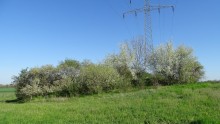|
|
|
|
StockhofRound Barrow(s)
|
||||||||||||||||||
|
|
|
Images (click to view fullsize) |
|
Photographs:


 Maps / Plans / Diagrams:
Maps / Plans / Diagrams:
|
Fieldnotes |
|
|
The Stockhof is a burial mound of the late Neolithic Bernburg culture near Gröna, a district of Bernburg (Saale). Here, a central wall chamber grave with several burials and numerous grave goods was found. Furthermore, a burial from the Migration Period was discovered in the hill bed. The hill is located a few hundred meters behind the eastern outskirts of Gröna directly on a power line. The hill is southwest-northeast oriented and originally had probably an oval shape. At the time of the excavation he had a length of 30 m and a width of 7 m. The stone on the hill probably has nothing to do with the tomb inside, but was added later. You drive from Gröna in the direction of Bernburg on the Grönaer Landstraße (K2105). Shortly after the last houses, the road turns left. There you drive straight ahead, 50 meters further on you will find the hill on the right, with the remains of the tomb. Visited April 2019 |
6th June 2019ce |
|
taken from the information board Arbeitskreis Archäologie im Bernburger Land e.V.: The Stockhof Middle Neolithic: Bernburg culture approx. 3,100 - 2,650 BC Late Migration Period: 6th century The Stockhof is one of the eponymous sites of the Bernburg culture and in terms of research history extremely significant. It is a typical representative of those burial mounds from the Middle Neolithic period, which once dominated the area around Bernburg. Few of them have survived until today (Schneiderberg near Baalberge, Spitzes Hoch and Pohlsberg near Latdorf). On the occasion of a summer excursion of the Berlin Society for Ethnology, Anthropology and Prehistory in 1884, the study of the hill was started by the Bernburg History and Antiquities Society in the presence of Rudolf Virchow, the well-known Berlin anatomist and prehistoric researcher, and completed just after a few days. The findings were not completely recovered by this inadequate examination method. In the middle of the hill was a construction of stratified fieldstone - a wall chamber grave - with numerous human skeletal remains (collective grave). The dead were partly buried in typical squat position, partly they were disorderly mixed-up. There were no burn marks as observed in the peak high at Latdorf. As grave goods about 60 pottery, flint blades and pierced Canidenzähne (jewelry) were salvaged. Unlike other hills other burials from the Neolithic or Bronze Age were not registered. However a body grave from the Migration Period (6th century) was found on the hillside periphery. The details of the grave construction and the ceramics found date from the hill around 3000 BC. At that time, the characteristic vase ceramic from the Stockhof, together with the corresponding finds from the Spitzen Hoch, were considered to be so important that in 1892 the Berlin prehistorian Alfred Götze spoke of the so-called "Bernburg type" for the first time. Today, the name "Bernburg Culture" is used for this archaeological group. |
6th June 2019ce Edited 6th June 2019ce |

